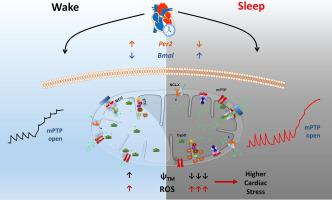Journal of Advanced Research ( IF 10.7 ) Pub Date : 2021-01-12 , DOI: 10.1016/j.jare.2021.01.006 Engy A Abdel-Rahman 1, 2, 3 , Salma Hosseiny 1 , Abdullah Aaliya 1 , Mohamed Adel 1 , Basma Yasseen 1, 2 , Abdelrahman Al-Okda 1 , Yasmine Radwan 1 , Saber H Saber 1 , Nada Elkholy 1 , Eslam Elhanafy 1 , Emily E Walker 4, 5 , Juan P Zuniga-Hertz 4, 5 , Hemal H Patel 4, 5 , Helen R Griffiths 6 , Sameh S Ali 1, 2

|
Introduction
Incidents of myocardial infarction and sudden cardiac arrest vary with time of the day, but the mechanism for this effect is not clear. We hypothesized that diurnal changes in the ability of cardiac mitochondria to control calcium homeostasis dictate vulnerability to cardiovascular events.
Objectives
Here we investigate mitochondrial calcium dynamics, respiratory function, and reactive oxygen species (ROS) production in mouse heart during different phases of wake versus sleep periods.
Methods
We assessed time-of-the-day dependence of calcium retention capacity of isolated heart mitochondria from young male C57BL6 mice. Rhythmicity of mitochondrial-dependent oxygen consumption, ROS production and transmembrane potential in homogenates were explored using the Oroboros O2k Station equipped with a fluorescence detection module. Changes in expression of essential clock and calcium dynamics genes/proteins were also determined at sleep versus wake time points.
Results
Our results demonstrate that cardiac mitochondria exhibit higher calcium retention capacity and higher rates of calcium uptake during sleep period. This was associated with higher expression of clock gene Bmal1, lower expression of per2, greater expression of MICU1 gene (mitochondrial calcium uptake 1), and lower expression of the mitochondrial transition pore regulator gene cyclophilin D. Protein levels of mitochondrial calcium uniporter (MCU), MICU2, and sodium/calcium exchanger (NCLX) were also higher at sleep onset relative to wake period. While complex I and II-dependent oxygen utilization and transmembrane potential of cardiac mitochondria were lower during sleep, ROS production was increased presumably due to mitochondrial calcium sequestration.
Conclusions
Taken together, our results indicate that retaining mitochondrial calcium in the heart during sleep dissipates membrane potential, slows respiratory activities, and increases ROS levels, which may contribute to increased vulnerability to cardiac stress during sleep-wake transition. This pronounced daily oscillations in mitochondrial functions pertaining to stress vulnerability may at least in part explain diurnal prevalence of cardiac pathologies.
中文翻译:

心脏线粒体中睡眠/唤醒钙动力学、呼吸功能和 ROS 的产生
介绍
心肌梗塞和心脏骤停的发生率随一天中的时间而变化,但这种影响的机制尚不清楚。我们假设心脏线粒体控制钙稳态的能力的昼夜变化决定了对心血管事件的易感性。
目标
在这里,我们研究了清醒与睡眠的不同阶段小鼠心脏中线粒体钙动力学、呼吸功能和活性氧 (ROS) 的产生。
方法
我们评估了来自年轻雄性 C57BL6 小鼠的离体心脏线粒体钙保留能力的时间依赖性。使用配备荧光检测模块的 Oroboros O2k 站探索了匀浆中线粒体依赖性耗氧量、ROS 产生和跨膜电位的节律性。基本时钟和钙动力学基因/蛋白质表达的变化也在睡眠与清醒时间点进行了测定。
结果
我们的结果表明,心脏线粒体在睡眠期间表现出更高的钙保留能力和更高的钙吸收率。这是与高表达时钟基因的相关BMAL1,低表达PER2,更大的表达MICU1基因(线粒体钙摄入1),以及线粒体转换孔调节基因的较低表达亲环d. 相对于清醒期,睡眠开始时线粒体钙单向转运蛋白 (MCU)、MICU2 和钠/钙交换剂 (NCLX) 的蛋白质水平也更高。虽然复合物 I 和 II 依赖的氧利用和心脏线粒体的跨膜电位在睡眠期间较低,但可能是由于线粒体钙螯合导致 ROS 产生增加。
结论
总之,我们的结果表明,在睡眠期间将线粒体钙保留在心脏中会消散膜电位,减慢呼吸活动,并增加 ROS 水平,这可能有助于在睡眠-觉醒过渡期间增加对心脏压力的脆弱性。与压力脆弱性有关的线粒体功能的这种明显的日常振荡可能至少部分解释了心脏病的昼夜流行。



























 京公网安备 11010802027423号
京公网安备 11010802027423号